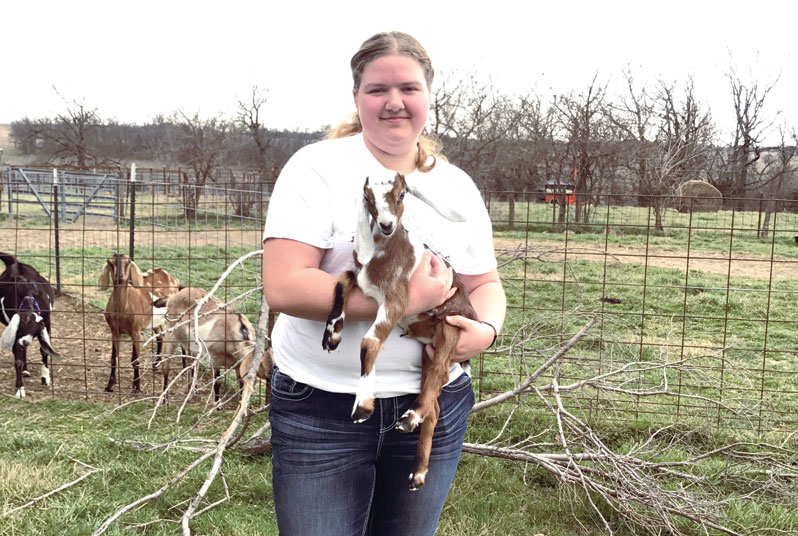While Erin Cahoj is an all-around animal lover, nothing quite compares to the way she cares for her goats.
“I’ve heard raising goats compared to potato chips – you can’t have just one,” Erin laughed as she admitted to the growth her goat operation has seen since she began in 2012.
From just a few goats, Oaken Acres now boasts 13 does, a buck, and counting. All of the goats are purebred Nubians, registered through American Dairy Goat Association. Erin prefers this breed because of the Roman noses and floppy ears, but particularly due to their nice tasting milk with high butterfat content. Nubians are the Jersey cows of the goat world, Erin explained.
With the help of her father, Ed, Erin milks her goats by hand, morning and evening. She uses the milk to make cheeses, including mozzarella and cheddar, and butter for her family, as well as selling a portion to be made into soap. A large percentage of the milk production is fed to the season’s kids.
Oaken Acres practices CAE prevention, meaning that this milk must be pasteurized and then bottle fed to the young goats. CAE (Caprine Arthritis Encephalitis) is passed from goat to goat through infected milk, colostrum or blood, and causes detrimental health defects to the animal. Although Erin also has her goats tested for CAE to ensure her herd stays negative, she believes that utilizing prevention tactics it still a good idea. Aside from bottle-feeding kids morning, noon, and night, Erin feeds powdered colostrum.
Erin uses lineal appraisal to base breeding off strengths and weaknesses of each goat. The animal’s score is based on appearance and build, and goes on their permanent record. Nubians are seasonal breeders, so by tracking her goats’ natural heat cycle, Erin breeds her does to kid in groups.
The first group of kids is born in February, the second in late April to early May. Kids range from 2 to 7 pounds at birth, and for their first few days of life, Erin nurses them in the warmth of her enclosed front porch. The kids begin nibbling on things pretty quickly, and are fully weaned within three to four months.
At this point, Erin must decide which of the kids will be kept to grow her own herd, or sold to families looking to expand theirs. Erin bases this decision off of her foundation doe, Spitfire.
“Spitfire milks great, has a good personality, stays healthy, is an easy keeper, and just a beautiful animal,” Erin said.
She tries to hold each set of kids to this standard, and has retained three daughters and one son of Spitfire’s thus far, in addition to kids from other does as well. The remaining goats are sold mainly locally, but Erin also does business in surrounding states. She is excited about a new business opportunity with a veteran’s home in Iowa, which is purchasing goats from Oaken Acres to make cheese and milk as a therapeutic experience for the veterans there.
Meanwhile, back on the farm, Erin has to choose what age to breed her does. First-year fresheners, bred in their first year of life, can be risky because they have not had as much time to develop as second fresheners. However, while second fresheners are more mature and could produce a better kid. More freshenings means a more proven goat, and Erin said that optimal kidding age is around 3 or 4. In the first couple years of her operation, Erin kept all of her does as second fresheners. Last year, she took the risk of first fresheners for the first time because the goats were developing so nicely.
“You have to watch them closer during birthing in case something goes wrong, but it’s exciting to see last year’s kids get to freshen this year,” Erin said with a smile.
As her goats pass the motherhood stage, Erin plans to retire them at Oaken Acres in gratitude for their work. She is currently in the process of downsizing her herd, but looks forward to starting official milk testing in the next few years. Erin has also done some showing, and would like to do more of that in the future as well.
“My enthusiasm for our goats keeps the project going.” Erin says.








